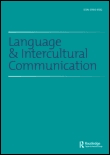
Language and Intercultural Communication
Scope & Guideline
Fostering Dialogue Across Cultural Boundaries
Introduction
Aims and Scopes
- Intercultural Communication Practices:
The journal emphasizes the study of communication practices that occur between individuals from different cultural backgrounds, exploring how language functions in these interactions. - Language Education and Pedagogy:
A significant focus is on pedagogical approaches to teaching languages that foster intercultural competence and sensitivity among learners. - Research Methodologies:
The journal promotes innovative research methodologies, including qualitative and ethnographic studies, to understand the nuances of language use in intercultural contexts. - Power Dynamics in Communication:
It explores the power relations embedded in language use and intercultural communication, particularly in relation to marginalized groups and issues of identity. - Digital Communication and Globalization:
The impact of digital communication on intercultural exchanges is a growing area of interest, examining how technology influences language and cultural interactions.
Trending and Emerging
- Intercultural Competence Development:
There is a growing focus on frameworks and practices aimed at developing intercultural competence among learners, particularly in higher education settings. - Digital and Virtual Interactions:
Research on the role of digital platforms and virtual exchanges in facilitating intercultural communication is increasingly prominent, reflecting the impact of globalization. - Language and Identity Negotiation:
Emerging studies are highlighting how individuals negotiate their identities through language in multicultural environments, especially among international students. - Ethnographic and Reflexive Research Methods:
The use of ethnographic and reflexive methodologies to explore language practices and intercultural dynamics is trending, emphasizing the importance of context and researcher positionality. - Critical Pedagogy and Social Justice:
Themes related to critical pedagogy and social justice are gaining traction, focusing on how language education can address issues of power, equity, and inclusion in diverse classrooms.
Declining or Waning
- Traditional Linguistic Studies:
There appears to be a waning interest in traditional linguistic studies that focus solely on grammar and syntax without considering cultural contexts. - Static Models of Culture:
The journal has shifted away from static models of culture, which view cultures as fixed entities, towards more dynamic and fluid understandings of culture. - National Identity in Language Education:
There is less emphasis on national identity as a central theme in language education, reflecting a broader trend towards globalization and transnational identities. - Binary Approaches to Language Proficiency:
The journal has moved away from binary classifications of language proficiency (e.g., native vs. non-native) in favor of more nuanced understandings of language use and competence. - Cultural Essentialism:
Research that promotes cultural essentialism, viewing cultures as homogeneous and unchanging, is declining in favor of perspectives that embrace cultural hybridity and intersectionality.
Similar Journals
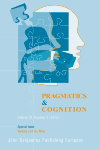
Pragmatics & Cognition
Navigating the Complexities of Language Use and MindPragmatics & Cognition, published by John Benjamins Publishing Co, is an esteemed journal that serves as a cross-disciplinary platform for the study of language, cognition, and context-dependent communication. With its ISSN 0929-0907 and E-ISSN 1569-9943, the journal has established a notable reputation since its inception in 1993, although its coverage spans various fields from behavioral neuroscience to linguistics and philosophy. Recognized for its scholarly contributions, it holds impressive Scopus rankings, significantly within Linguistics and Language, where it ranks in the 63rd percentile among peers. Although it currently maintains a Q4 designation in Behavioral Neuroscience and a Q1 in Linguistics and Language as of 2023, the journal appeals to a diverse audience addressing the intricate relationships between language use and cognitive processes. As researchers and academics navigate this evolving landscape, Pragmatics & Cognition remains pivotal in fostering essential dialogues and advancing knowledge in the interdisciplinary field, providing rich content that is both insightful and relevant.

MUTTERSPRACHE
Advancing Knowledge in Language StudiesMUTTERSPRACHE is a prominent journal published by GESELLSCHAFT DEUTSCHE SPRACHE, focusing on the fields of linguistics and language studies. Based in Wiesbaden, Germany, this esteemed publication brings together a diverse spectrum of research articles, reviews, and discussions that delve into both the theoretical and practical aspects of language use. With the ISSN 0027-514X and notable inclusion in Scopus rankings, it stands at Q3 in Linguistics and Language for 2023, reflecting its relevance in academia. Though not an Open Access journal, *MutterSprache* offers a valuable repository of knowledge for researchers, professionals, and students interested in the nuances of German language and broader linguistic phenomena. The journal has been converging its scope from 2002 to 2024, ensuring a comprehensive exploration of evolving language trends and linguistic research methodologies.
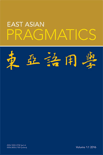
East Asian Pragmatics
Fostering Understanding Across Linguistic LandscapesEast Asian Pragmatics, published by EQUINOX PUBLISHING LTD, serves as a critical platform for interdisciplinary research in the fields of Communication, Cultural Studies, and Linguistics. With an ISSN of 2055-7752 and an E-ISSN of 2055-7760, this journal has established significant relevance, evidenced by its Q2 and Q3 classifications in critical academic categories for 2023. Spanning the years from 2018 to 2024, East Asian Pragmatics aims to advance understanding of pragmatics within the context of East Asia, facilitating scholarly discourse that bridges linguistic insights with cultural phenomena. Its Scopus ranking highlights its growing importance, particularly in cultural studies and linguistics where it ranks in the top half of its categories. Researchers, professionals, and students are encouraged to explore the wealth of knowledge and unique perspectives presented in its articles, contributing to the vibrant tapestry of East Asian linguistic and cultural studies.
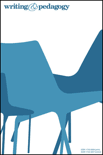
Writing & Pedagogy
Fostering New Horizons in Writing and LearningWriting & Pedagogy is a renowned academic journal published by EQUINOX PUBLISHING LTD that aims to explore the dynamic interplay between writing and teaching methodologies within the fields of education and linguistics. Since its launch, the journal has rapidly become a vital resource for scholars, practitioners, and students interested in the evolving landscape of literacy, composition, and educational practice. The journal is indexed in Scopus, highlighting its relevance and contribution to the fields, with a current ranking of #499 in Language and Linguistics and #578 in Social Sciences within Linguistics. With a Q4 classification in Education and a Q3 classification in Linguistics and Language as of 2023, it reflects a commitment to quality scholarship while offering open access to a wide range of articles that promote innovative pedagogical approaches. As the journal converges from 2018 to 2023, it continues to attract contributions that push the boundaries of traditional discourse, making it an essential read for anyone engaged in the vital work of writing education and pedagogy.
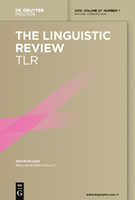
LINGUISTIC REVIEW
Unveiling Insights in Linguistics and Language.LINGUISTIC REVIEW is a prestigious academic journal published by De Gruyter Mouton that has established itself as a leading platform in the field of Linguistics and Language. With an impressive impact factor and categorized in the Q1 Quartile for the year 2023, this journal ranks within the top tiers of its discipline, indicating its influential contributions to linguistic research. Covering an extensive range of topics from theoretical frameworks to applied linguistics, the journal aims to foster scholarly dialogue and advance the understanding of language in its myriad forms. Researchers and students alike will benefit from the rigorous peer-review process and the availability of in-depth studies published from 1981 onwards. While the journal is not open access, it is renowned for its exceptional quality and relevance in both the Arts and Humanities and Social Sciences classifications, with Scopus rankings placing it in the top percentile of its peers. By offering insight from leading scholars, LINGUISTIC REVIEW remains an indispensable resource for those who are passionate about linguistic inquiry and its real-world applications.
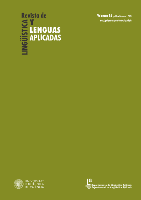
Revista de Linguistica y Lenguas Aplicadas
Exploring the Dynamics of Language and CommunicationRevista de Linguistica y Lenguas Aplicadas, an esteemed journal published by UNIV POLITECNICA VALENCIA, EDITORIAL UPV, is a pivotal resource in the field of linguistics and applied languages. Since its inception, the journal has embraced Open Access publishing since 2006, ensuring that its rich repository of research is readily available to a global audience of researchers, academics, and language professionals. Headquartered in Valencia, Spain, the journal contributes significantly to the advancement of linguistics knowledge, boasting a respectable ranking within the Q3 quartile for Linguistics and Language (2023) according to Scopus metrics. It covers a diverse range of topics and methodologies, engaging readers through its commitment to scholarly rigor and innovation. The journal is uniquely positioned to inform and inspire essential discussions from 2015 to 2024, making it a vital platform for emerging linguists and seasoned scholars alike, as they explore the evolving landscapes of language and communication.
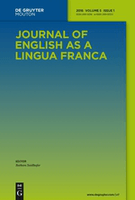
Journal of English as a Lingua Franca
Exploring the Dynamics of Global CommunicationJournal of English as a Lingua Franca, published by WALTER DE GRUYTER GMBH, stands at the forefront of academic discourse in the fields of linguistics and communication. With an impressive impact factor placed in the Q1 and Q2 quartiles for Linguistics and Communication respectively, this journal serves as a critical platform for researchers and educators interested in the dynamics of English as a global lingua franca. Since its inception in 2012, the journal has actively contributed to the understanding of language use across diverse communities and contexts, addressing the implications of English as a shared mode of communication. Housed in Germany, the journal's open-access model fosters accessibility and encourages knowledge sharing within the global academic community. By providing rigorous peer-reviewed articles, the Journal of English as a Lingua Franca remains an essential resource for those committed to advancing research in this vibrant linguistic landscape.

Circulo de Linguistica Aplicada a la Comunicacion
Fostering Academic Discourse in Language ResearchCirculo de Linguistica Aplicada a la Comunicacion is a premier open-access journal published by UNIV COMPLUTENSE MADRID, SERVICIO PUBLICACIONES, since 2000, that serves as a vital resource for researchers, professionals, and students in the fields of linguistics and language studies. With an ISSN of 1576-4737, this journal is recognized for its rigorous scholarship and has achieved a notable Q1 quartile ranking in Linguistics and Language as of 2023. The journal's impact extends across diverse domains, holding significant positions in both the Arts and Humanities and Social Sciences categories, ranking #354/1088 and #419/1167 in Scopus, respectively. It features a rich array of research articles that delve into applied linguistics, communication theories, and language pedagogy, creating a comprehensive platform for academic discourse. By fostering collaboration and innovation in language research, Circulo de Linguistica Aplicada a la Comunicacion remains a crucial contributor to the enrichment of knowledge and understanding within the global linguistic community.

Language Learning in Higher Education
Fostering scholarly dialogue on language pedagogy.Language Learning in Higher Education is a prominent academic journal published by DE GRUYTER MOUTON, dedicated to exploring the intricate dynamics of language acquisition and pedagogical practices within the higher education context. With a robust ISSN: 2191-611X and E-ISSN: 2191-6128, this journal provides a platform for innovative research that addresses contemporary challenges and methodologies in language education. The journal enjoys a favorable reputation in the academic community, as evidenced by its ranks in the Scopus database, where it holds a position in the 67th percentile for Language and Linguistics and is classified in the Q3 and Q2 quartiles across relevant education and linguistics categories. Since its convergence in 2017, Language Learning in Higher Education aims to enrich scholarly discourse by publishing high-quality articles that foster insights into effective language learning strategies, thus serving as an essential resource for researchers, educators, and students committed to enhancing language education. The journal's editorial team is devoted to advancing the field through rigorous peer-review processes and welcomes contributions that push the boundaries of language learning research.

Intercultural Pragmatics
Unlocking the Secrets of Language in Diverse Contexts.Intercultural Pragmatics, published by De Gruyter Mouton in Germany, stands at the forefront of the study of communication across diverse cultures, bridging the gap between linguistic theory and real-world intercultural exchanges. With an ISSN of 1612-295X and an E-ISSN of 1613-365X, this esteemed journal has been contributing to the field since its inception in 2004, showcasing rigorous scholarship through its convergence of literature up to 2024. The journal enjoys a commendable reputation, positioned in the Q2 quartile of Communication and the Q1 quartile of Linguistics and Language, reflecting its significant impact within the academic community. As recognized in Scopus rankings, it is ranked #122 out of 1088 in Arts and Humanities (Language and Linguistics) and holds an impressive 88th percentile, making it an essential resource for researchers, professionals, and students eager to deepen their understanding of intercultural dynamics. While access options remain standard, the journal prioritizes groundbreaking insights and theoretical advancements that contribute to the ever-evolving landscape of linguistics and intercultural communication.